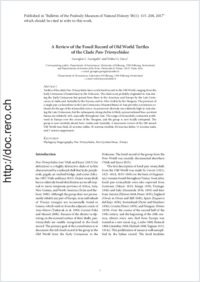A review of the fossil record of old world turtles of the clade pan-trionychidae
- Georgalis, Georgios L. Department of Geosciences, University of Fribourg, Switzerland
- Joyce, Walter G. Department of Geosciences, University of Fribourg, Switzerland
-
01.04.2017
Published in:
- Bulletin of the Peabody Museum of Natural History. - 2017, vol. 58, no. 1, p. 115–208
English
Turtles of the clade Pan-Trionychidae have a rich fossil record in the Old World, ranging from the Early Cretaceous (Hauterivian) to the Holocene. The clade most probably originated in Asia during the Early Cretaceous but spread from there to the Americas and Europe by the Late Cretaceous, to India and Australia by the Eocene, and to Afro-Arabia by the Neogene. The presence of a single pan-cyclanorbine in the Late Cretaceous (Maastrichtian) of Asia provides a minimum estimate for the age of the trionychid crown. As preserved, diversity was relatively high in Asia during the Late Cretaceous, but the subsequent, strong decline is likely a preservational bias, as extant faunas are relatively rich, especially throughout Asia. The range of trionychids contracted southward in Europe over the course of the Neogene, and the group is now locally extirpated. The group is now similarly absent from Arabia and Australia. A taxonomic review of the 180 named Old World taxa finds 42 nomina valida, 38 nomina invalida, 88 nomina dubia, 11 nomina nuda, and 1 nomen suppressum.
- Faculty
- Faculté des sciences et de médecine
- Department
- Département de Géosciences
- Language
-
- English
- Classification
- Palaeontology
- License
- License undefined
- Identifiers
-
- RERO DOC 288660
- DOI 10.3374/014.058.0106
- Persistent URL
- https://folia.unifr.ch/unifr/documents/305568
Statistics
Document views: 147
File downloads:
- joy_rfr.pdf: 893
